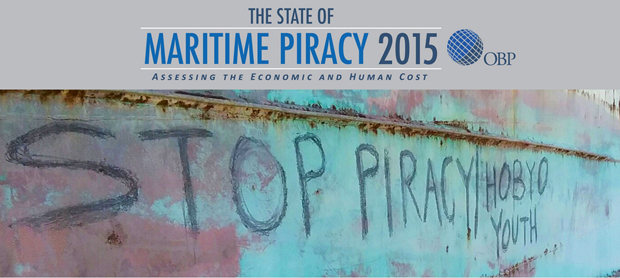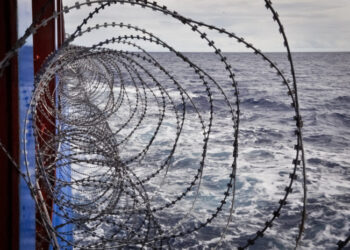Oceans Beyond Piracy (OBP) has launched this year’s report ”The State of Maritime Piracy 2015” which marks the sixth year that OBP has assessed the human and economic cost of maritime piracy. Over the years the report has evolved and its focus has expanded from piracy off the coast of Somalia to piracy in the Gulf of Guinea, and finally to piracy and robbery at sea in Southeast Asia.
The report reveals the following notable trends and key findings in 2015 by region:
1. Western Indian Ocean Region
Trend
Despite reduced spending, international efforts in the Indian Ocean continued to suppress major attacks. However, several recent hijackings of regional vessels could signal an increased threat.
Economic Cost
• The presence of coalition and independent deployers engaged in counter-piracy activities decreased by 15% in 2015.
• Merchant vessels are again using pre-piracy shipping routes close to the east coast of Africa and through the Mozambique Channel.
• The High Risk Area was reduced in December, 2015 which corresponded with a sharp decline in PCASP team employment.
• Fuel costs decreased by nearly 50%, resulting in significant cost savings related to naval deployments and increased speeds.
Human Cost
• The number of seafarers held hostage by pirates increased in 2015, with 108 seafarers held by pirates at some point over the course of the year.
• 78 of the 108 seafarers held were aboard vessels hijacked in 2015.
• 41 hostages remain in pirate hands as of this writing:
– 26 crew members of the Naham 3 have been held for 1,499 days.
– 15 remaining crew members of the Siraj for 405 days.
Pirate Activity
• Vessels near Somalia continue to report suspicious activity related to piracy. While many of these reports may be regional maritime commerce, OBP identified 9 incidents in 2015 which appear to present credible evidence of pirate activity.
• Restrictive reporting definitions and frameworks may be masking important indicators and warnings of increased pirate activity.
• Numerous reports from Somali sources emphasize the risk of piracy resurging in some form if the naval presence dissipates.
You may read full Western Indian Ocean Report on OBP’s website here
Also view related video by OBP Somali pirates : Reseting the stage?
2. Gulf of Guinea
Trend
The Gulf of Guinea is the most dangerous region for seafarers with a rise in violence across the year and an increase in kidnap-for-ransom in the fourth quarter of 2015.
Economic Cost
• States in the Gulf of Guinea region continue to increase maritime security and cooperation, but capacity is still lacking.
• Fuel costs decreased by nearly 50%, resulting in significant cost savings related to naval patrols and deployments.
• OBP estimates show that $349.1 million, 49% of total costs – was spent on Contracted Maritime Security (embarked teams, secure zone fees, contracted patrol vessels, and security escorts) in 2015.
Human Cost
• Piracy in the Gulf of Guinea was significantly more violent in 2015 than in the previous year.
• Pirate attacks in the Gulf of Guinea are the most violent of the regions studied and often include direct confrontation with the crew.
• The duration of kidnap and ransom incidents is consistent with 2014 (2 and 3 weeks of captivity) however, there has been a significant increase in violence including physical abuse and mock executions in 2015.
• Lack of piracy prosecutions and a rule of law finish continue to undermine regional efforts to combat piracy
Pirate Activity
• The total number of attacks remained within historic norms, but the Kidnap for Ransom model is the most dangerous.
• There was only one recorded incident of cargo theft in 2015 (there were 5 in 2014).
• Kidnap for ransom attacks were directed at a greater diversity of shipping targets and are now a threat to all types of vessels.
• Increased Nigerian law enforcement patrols have forced pirates to change their business model, and pirates have had to expand their range beyond Nigerian waters in search of targets.
You may read full Gulf of Guinea Report on OBP’s website here
Also view related OBP video Piracy in the Gulf of Guinea: No Justice for Seafarers
Southeast Asia
Trend
Cooperative regional measures in Southeast Asia resulted in steep declines in piracy attacks in the second half of 2015.
Economic Cost
• The complexity of shipping patterns and the nature of regional responses preclude OBP’s ability to estimate aggregate costs.
• OBP has identified specific areas and incidents to illustrate the various cost factors.
• While the region has stood up rapid response capabilities and enhanced information sharing, it is difficult to isolate specific counter-piracy and robbery at sea costs for the purposes of this report.
Human Cost
• OBP assesses that SE Asian Piracy and Armed Robbery affected 3,674 seafarers in 2015, but in most cases the perpetrators are unarmed and seek to avoid violent confrontation with the crew.
• Hijacking for Cargo Theft attacks are the most likely to result in abuse of the crew due to the prolonged duration and need to take control of the vessel. However, there has been no such attack reported since August 2015.
• The kidnap for ransom model of hijacking was largely absent in SE Asia in 2015
Pirate Activity
• Expanded regional cooperation in maritime patrolling, information sharing, and prosecutions have effectively reversed a rising trend in piracy attacks.
• Effective cooperation developed between regional states and the shipping industry culminated with the publication of comprehensive industry guidance developed by regional organizations and industry groups.
• Since the concentration of shipping traffic and complex geography provides a favorable environment for maritime crime, the maritime community must maintain vigilance at all times.
• SE Asian piracy has seen spikes over the last 15 years, but the region has proven capable of suppressing piracy when challenged.
You may read full Southeast Asia Report on OBP’s website here
Also view related OBP video Counter-Piracy in Southeast Asia: The Search for the Orkim Harmony
Source: Oceans Beyond Piracy (OBP)

































































